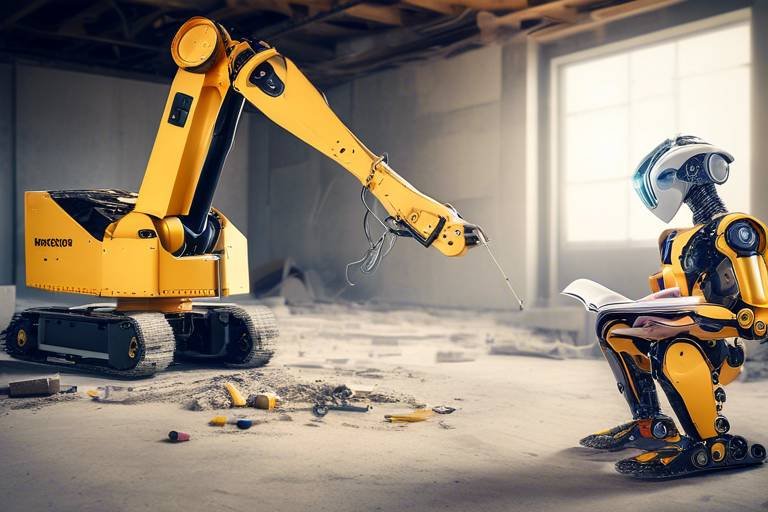How Robotics is Improving Manufacturing Efficiency
In today's fast-paced world, the manufacturing industry is undergoing a significant transformation, largely driven by advancements in robotics. As businesses strive to enhance productivity and maintain a competitive edge, the integration of robotic systems has become a game-changer. Imagine a factory where machines work tirelessly alongside humans, performing repetitive tasks with precision and speed. This is not a scene from a futuristic movie; it's the reality of modern manufacturing. Robotics is not just about replacing human labor; it's about augmenting capabilities, reducing errors, and optimizing processes.
The impact of robotics on manufacturing efficiency is profound. From assembly lines to quality control, robots are revolutionizing how products are made. They are designed to handle tasks that are either too dangerous, too tedious, or too complex for human workers. By automating these processes, companies can achieve higher production rates while minimizing operational costs. This not only enhances profitability but also allows human workers to focus on more strategic and creative tasks that require critical thinking and problem-solving skills.
Moreover, the implementation of robotics leads to improved product quality. Robots operate with a level of precision that is difficult for humans to match. For instance, in industries such as automotive manufacturing, robotic arms can weld and paint vehicles with consistent quality, ensuring that every product meets stringent standards. This reduction in defects not only saves time and money but also boosts customer satisfaction, as consumers receive higher-quality products.
In addition to quality and efficiency, robotics also contribute to a safer working environment. By taking over hazardous tasks, robots help reduce workplace injuries, allowing human workers to operate in safer conditions. This shift not only protects employees but also contributes to lower insurance costs and fewer disruptions in production. As companies adopt robotic solutions, they are not just investing in technology; they are investing in their workforce's well-being.
As we dive deeper into the world of manufacturing robotics, it becomes clear that the future holds even more exciting developments. With innovations such as artificial intelligence and machine learning, robots are becoming smarter, more adaptable, and increasingly capable of handling complex tasks. This evolution paves the way for even greater efficiency and productivity gains, making it an exciting time for the manufacturing sector.
Automation has revolutionized the manufacturing landscape, enabling faster production rates and higher precision. This section delves into how automated systems streamline operations and enhance overall efficiency.
Various types of robots are employed in manufacturing, each serving distinct purposes. This section discusses collaborative robots, industrial robots, and mobile robots, highlighting their specific applications and benefits.
Collaborative robots work alongside human operators, enhancing safety and productivity. This subsection examines how cobots are designed for shared workspaces and their growing role in modern manufacturing.
Cobots offer numerous advantages, including flexibility and ease of programming. This part discusses how these robots can adapt to various tasks and improve workflow efficiency.
Despite their benefits, cobots face challenges such as safety concerns and integration issues. This section addresses potential obstacles manufacturers may encounter when implementing collaborative robots.
Industrial robots are designed for high-volume production tasks, providing speed and precision. This subsection explores their applications in welding, painting, and assembly lines.
The introduction of robotics in manufacturing raises questions about labor displacement and workforce transformation. This section evaluates how robots change job roles and the skills required in the industry.
As robotics take over repetitive tasks, reskilling becomes essential. This part discusses training programs and initiatives to equip workers with the skills needed to thrive alongside automation.
While some jobs may be lost, robotics also creates new opportunities. This subsection highlights emerging roles in robot maintenance, programming, and system integration within the manufacturing sector.
- What are the primary benefits of using robotics in manufacturing? Robotics enhances efficiency, reduces operational costs, improves product quality, and creates safer work environments.
- Will robots replace all human jobs in manufacturing? While robots will take over repetitive tasks, they will also create new job opportunities that require human oversight and management.
- How do collaborative robots differ from traditional industrial robots? Collaborative robots are designed to work alongside humans, prioritizing safety and flexibility, whereas traditional industrial robots typically operate in isolated environments.
- What skills will be in demand as robotics become more prevalent? Skills in robotics maintenance, programming, and system integration will be increasingly valuable in the evolving manufacturing landscape.

The Role of Automation in Manufacturing
Automation has become a game-changer in the manufacturing industry, fundamentally altering how products are made and how businesses operate. Imagine a world where machines perform repetitive tasks with unwavering precision, allowing human workers to focus on more complex and creative responsibilities. This is not just a futuristic fantasy; it’s the reality that automation has ushered in. By implementing automated systems, manufacturers can achieve faster production rates, enhance product quality, and significantly reduce operational costs.
One of the most significant impacts of automation is its ability to streamline operations. For instance, automated assembly lines can work tirelessly around the clock, producing goods at a rate that far exceeds human capabilities. This increased efficiency leads to shorter lead times and a more agile response to market demands. As a result, companies can meet customer needs more effectively, which is crucial in today’s fast-paced business environment.
Moreover, automation minimizes the chances of human error, which is a common issue in manual production processes. When machines take over repetitive and mundane tasks, the consistency of output improves dramatically. This not only enhances product quality but also boosts customer satisfaction. In fact, many manufacturers report a significant decrease in defects and rework when automation is introduced into their processes.
Another fascinating aspect of automation is its ability to gather and analyze data in real-time. Automated systems equipped with sensors and software can monitor production processes, identify bottlenecks, and suggest optimizations. This data-driven approach allows manufacturers to make informed decisions, leading to continuous improvement in their operations. It’s like having a crystal ball that helps businesses foresee challenges and tackle them before they escalate.
However, it’s essential to recognize that implementing automation is not without its challenges. Manufacturers must invest in the right technology and training to ensure a smooth transition. Additionally, the integration of automated systems into existing workflows requires careful planning to avoid disruptions. Despite these challenges, the benefits of automation far outweigh the hurdles, making it a critical component of modern manufacturing.
To sum up, automation plays a pivotal role in transforming the manufacturing landscape. By enhancing efficiency, improving quality, and enabling data-driven decisions, automation is not just a trend; it’s a necessity for businesses aiming to thrive in a competitive market. As we move forward, embracing automation will be key to unlocking new levels of productivity and innovation.
- What are the main benefits of automation in manufacturing? Automation increases production speed, improves quality, reduces costs, and allows for real-time data analysis.
- Are there any downsides to automation? Yes, challenges include high initial costs, potential job displacement, and the need for workforce reskilling.
- How does automation affect product quality? Automation reduces human error, leading to more consistent and higher-quality products.
- Can small manufacturers benefit from automation? Absolutely! Automation can be scaled to fit businesses of all sizes, improving efficiency and competitiveness.

Types of Robotics Used in Manufacturing
In the ever-evolving world of manufacturing, robotics plays a pivotal role in enhancing productivity and efficiency. There are several types of robots utilized in this sector, each tailored to meet specific needs and challenges. Understanding these types can help businesses make informed decisions about integrating robotics into their operations. The main categories include collaborative robots (cobots), industrial robots, and mobile robots. Let’s dive deeper into each type and see how they contribute to modern manufacturing.
Collaborative robots, or cobots, are designed to work alongside human operators, making them an excellent choice for environments where flexibility and safety are paramount. Unlike traditional industrial robots that operate in isolated settings, cobots share workspaces with humans, enhancing productivity without compromising safety. They are equipped with advanced sensors and AI algorithms, allowing them to detect human presence and adjust their actions accordingly. This collaboration not only boosts efficiency but also fosters a more harmonious workplace.
The advantages of cobots are numerous and compelling. First and foremost, they are incredibly flexible and can be easily programmed to perform various tasks, from assembly to quality control. This adaptability means that manufacturers can quickly shift production lines without the need for extensive reconfiguration. Additionally, cobots are generally more cost-effective than traditional robots, making them accessible to small and medium-sized enterprises (SMEs) as well. Their ease of use allows even non-technical staff to operate them, reducing the barrier to entry for businesses looking to adopt automation.
However, the integration of cobots is not without challenges. One significant concern is safety. While cobots are designed to be safe, manufacturers must still implement stringent safety protocols to prevent accidents. Moreover, there are potential integration issues with existing systems, which can lead to operational hiccups. Manufacturers must carefully assess their current processes and infrastructure to ensure that cobots can be effectively integrated without causing disruption.
On the other end of the spectrum, we have industrial robots, which are built for high-volume production tasks that require speed and precision. These robots are often utilized in applications such as welding, painting, and assembly lines. Their ability to perform repetitive tasks with consistent accuracy makes them invaluable in manufacturing settings where quality control is critical. Many industrial robots are equipped with advanced vision systems and AI, enabling them to adapt to different tasks and improve over time.
Another exciting development in manufacturing robotics is the emergence of mobile robots. These robots are designed for tasks such as material handling and logistics within manufacturing facilities. With the ability to navigate through complex environments, mobile robots can transport materials from one location to another, reducing the need for human labor in potentially hazardous areas. Additionally, they can be programmed to optimize routes, further enhancing operational efficiency.
In summary, the types of robotics used in manufacturing are diverse, each offering unique benefits and challenges. By understanding these different categories—cobots, industrial robots, and mobile robots—manufacturers can better strategize their automation efforts, leading to improved productivity and operational efficiency.
- What are collaborative robots?
Collaborative robots, or cobots, are designed to work alongside humans in shared workspaces, enhancing safety and productivity. - How do industrial robots differ from cobots?
Industrial robots are typically used for high-volume tasks in isolated environments, while cobots are made to collaborate with human workers. - What are the main benefits of using robotics in manufacturing?
Robotics can improve efficiency, reduce costs, enhance quality, and create safer work environments. - Are there any challenges in implementing robots in manufacturing?
Yes, challenges include safety concerns, integration issues, and the need for worker reskilling.

Collaborative Robots (Cobots)
Collaborative robots, commonly known as cobots, are a game-changer in the manufacturing sector. Unlike traditional industrial robots that operate in isolation, cobots are designed to work alongside human operators in shared workspaces. This collaboration not only enhances productivity but also promotes a safer working environment. Imagine a manufacturing floor where humans and robots seamlessly interact, each complementing the other's strengths. This is the reality that cobots bring to life.
The design of cobots emphasizes safety, allowing them to operate in close proximity to humans without the need for extensive safety barriers. Equipped with advanced sensors and smart technology, these robots can detect human presence and adjust their actions accordingly. This leads to a significant reduction in workplace accidents and fosters a culture of safety and efficiency. For instance, if a worker inadvertently steps too close, a cobot can slow down or stop its operation, preventing potential injuries.
One of the standout features of cobots is their flexibility. They can be easily programmed to perform a variety of tasks, making them suitable for diverse applications within the manufacturing process. Whether it’s assembling parts, packaging products, or even conducting quality inspections, cobots can adapt to different roles without requiring extensive reconfiguration. This adaptability not only saves time but also enhances workflow efficiency, allowing manufacturers to respond swiftly to changing demands.
Moreover, the ease of programming cobots is a significant advantage. Many cobots come with user-friendly interfaces that allow operators with minimal technical skills to set them up and modify their tasks quickly. This democratization of technology means that even small to medium-sized enterprises can leverage automation without needing a team of engineers. As a result, cobots empower businesses to scale operations and improve their competitive edge in the market.
However, the integration of cobots is not without its challenges. Manufacturers may face safety concerns as they introduce these robots into their workflows. While cobots are designed to be safe, there’s still a learning curve for employees who must adapt to working alongside them. Additionally, there can be integration issues when cobots are introduced into existing systems, particularly if the infrastructure is outdated or incompatible. It’s essential for companies to invest in training and gradual implementation to ensure a smooth transition.
In conclusion, collaborative robots are revolutionizing the manufacturing landscape by enhancing productivity, improving safety, and offering unparalleled flexibility. As industries continue to embrace automation, the role of cobots will undoubtedly expand, paving the way for a new era of manufacturing where humans and robots work hand in hand.
- What are collaborative robots?
Collaborative robots, or cobots, are designed to work alongside human operators in shared environments, enhancing safety and productivity.
- How do cobots improve safety in manufacturing?
Cobots are equipped with sensors that allow them to detect human presence, reducing the risk of accidents by adjusting their actions accordingly.
- Can cobots be used for multiple tasks?
Yes, cobots are highly flexible and can be programmed to perform various tasks, making them suitable for diverse manufacturing applications.
- What challenges do manufacturers face when implementing cobots?
Challenges include safety concerns, integration issues with existing systems, and the need for employee training to adapt to new workflows.

Benefits of Cobots
Collaborative robots, or cobots, are rapidly becoming a game-changer in the manufacturing industry, and their benefits are numerous and impactful. One of the most significant advantages of cobots is their flexibility. Unlike traditional industrial robots that are often designed for specific tasks, cobots can be easily reprogrammed to handle various functions. This adaptability means that manufacturers can quickly shift production lines to meet changing demands without incurring substantial downtime. Imagine a factory that can switch from assembling one type of product to another in a matter of hours—this is the power of cobots!
Another standout feature of cobots is their ease of programming. Many cobots come equipped with user-friendly interfaces that allow operators to teach them new tasks with minimal training. This accessibility lowers the barrier to entry for companies that may not have extensive technical expertise. The result? A more efficient workflow where human workers can focus on higher-level tasks while cobots handle repetitive or mundane jobs.
Furthermore, cobots are designed to work safely alongside human operators, enhancing workplace safety. They are equipped with advanced sensors and safety features that allow them to detect human presence and adjust their movements accordingly. This means that instead of creating a hazardous environment, cobots can help create a collaborative workspace where humans and machines coexist harmoniously. For instance, in a scenario where a human worker is assembling parts, a cobot can assist by fetching tools or holding components in place, significantly reducing the risk of injury.
Additionally, the integration of cobots leads to improved product quality. With their precision and consistency, cobots can minimize errors that often occur in manual processes. This results in a higher quality of products, which not only satisfies customer demands but also enhances a company's reputation in the market. Imagine producing a batch of products with fewer defects—this not only saves money on rework but also boosts customer satisfaction.
To summarize, the benefits of cobots in manufacturing are vast and varied. They offer
- Flexibility to adapt to different tasks
- Ease of programming for quick deployment
- Enhanced safety for human workers
- Improved product quality with precision

Challenges of Cobots
While collaborative robots (cobots) present a plethora of benefits, they are not without their challenges. One of the primary concerns is safety. Although cobots are designed to work alongside humans, ensuring a safe working environment is paramount. This involves not just the technology itself but also the human operators who must adapt to new workflows. The integration of cobots into traditional manufacturing settings can lead to potential hazards if proper protocols are not established. For instance, if a cobot malfunctions or if an operator is not adequately trained, the risk of accidents increases significantly.
Another challenge is the integration issues that arise when introducing cobots into existing systems. Many manufacturing facilities are equipped with legacy systems that may not be compatible with modern robotic technologies. This can lead to increased costs and longer implementation times as companies must either upgrade their entire system or find ways to make the cobots work with outdated technology. Additionally, the complexity of programming cobots to perform various tasks can be daunting. While many cobots are marketed as user-friendly, the reality is that they often require a certain level of technical expertise to operate effectively.
Furthermore, there is a cultural resistance to adopting new technologies within the workforce. Employees may feel threatened by the introduction of cobots, fearing job displacement or changes to their roles. This resistance can create a divide between management and workers, making it essential for companies to foster a culture of collaboration and open communication. Addressing these concerns through training and transparent discussions can help mitigate fears and encourage a smoother transition.
In summary, while cobots offer exciting opportunities for enhancing productivity and safety in manufacturing, their implementation is not without hurdles. Companies must navigate safety protocols, integration challenges, and workforce apprehensions to fully realize the potential of collaborative robots.
- What are cobots? Cobots are collaborative robots designed to work alongside human operators, enhancing productivity and safety in manufacturing environments.
- What challenges do cobots face? Challenges include safety concerns, integration issues with existing systems, and cultural resistance from the workforce.
- How can companies address these challenges? Companies can address these challenges by implementing robust safety protocols, investing in training programs, and fostering an open dialogue with employees about the benefits of cobots.

Industrial Robots
Industrial robots have become the backbone of modern manufacturing, revolutionizing the way products are made. These machines are engineered for high-volume production tasks, offering unparalleled speed and precision. Imagine a robotic arm that can assemble intricate components in a fraction of the time it would take a human worker. That's the power of industrial robots! They are not just faster; they also maintain a level of consistency that is hard to achieve manually. This consistency leads to reduced errors and higher quality products, which is a win-win for manufacturers.
One of the most notable applications of industrial robots is in assembly lines. Here, these machines can perform repetitive tasks, such as picking, placing, and assembling parts. Their ability to work tirelessly without breaks means that production can continue around the clock, significantly increasing output. For instance, in the automotive industry, robots are employed for tasks like welding and painting, where precision is crucial. The use of robots in these processes not only speeds up production but also enhances the safety of the work environment by taking over dangerous tasks.
Moreover, the integration of advanced technologies, such as Artificial Intelligence (AI) and Machine Learning (ML), has taken industrial robots to the next level. These technologies enable robots to learn from their environment and improve their performance over time. For example, a robot in a manufacturing plant can analyze its own efficiency and adjust its operations to minimize downtime. This adaptability is what sets modern industrial robots apart from their predecessors.
However, the implementation of industrial robots is not without its challenges. The initial investment can be quite significant, and manufacturers must consider the costs associated with training staff to operate and maintain these machines. Additionally, there is a need for ongoing maintenance to ensure that the robots function correctly and efficiently. Despite these challenges, the benefits often outweigh the drawbacks, leading many companies to adopt robotic solutions.
To illustrate the impact of industrial robots, consider the following table that compares production efficiency before and after the implementation of industrial robots:
| Production Aspect | Before Robots | After Robots |
|---|---|---|
| Production Rate (units/hour) | 50 | 200 |
| Error Rate (%) | 5 | 1 |
| Labor Costs ($/hour) | 30 | 15 |
This table clearly shows that the introduction of industrial robots can quadruple production rates while significantly reducing error rates and labor costs. As industries continue to evolve, the role of industrial robots will only become more prominent, driving innovation and efficiency in manufacturing processes.

Impact on Labor and Workforce
The introduction of robotics in manufacturing raises significant questions about the future of labor and the workforce. As machines take on more tasks, especially those that are repetitive and mundane, many people worry about job displacement. However, it's essential to understand that while some roles may diminish, others are evolving and emerging. The reality is that robotics is not just about replacing human workers; it's also about transforming the nature of work itself. Think of it like a game of chess—while some pieces may be removed from the board, new strategies and roles develop as the game progresses.
When we consider the impact of robotics on labor, we must acknowledge both the challenges and the opportunities presented. On one hand, the fear of losing jobs is very real. Many workers in traditional manufacturing roles might find themselves facing uncertainty as automation becomes more prevalent. On the other hand, this shift is creating a demand for new skills and roles that didn't exist before. For example, positions in robot maintenance, programming, and system integration are on the rise. In fact, a recent study indicated that nearly 60% of manufacturers reported a need for skilled workers who can operate and maintain robotic systems.
Moreover, it's crucial to recognize that the integration of robotics into manufacturing processes is often accompanied by a need for reskilling the workforce. As robots take over repetitive tasks, companies are investing in training programs to help their employees transition into new roles that require more complex problem-solving and technical skills. This is not just a matter of keeping jobs; it's about enhancing the workforce's capabilities to thrive in an increasingly automated environment.
To illustrate this point, consider the following table that outlines the evolving roles in manufacturing due to robotics:
| Traditional Role | Emerging Role | Required Skills |
|---|---|---|
| Assembly Line Worker | Robot Technician | Machine maintenance, troubleshooting |
| Quality Control Inspector | Data Analyst | Data interpretation, statistical analysis |
| Manual Laborer | Automation Specialist | Programming, system integration |
As we navigate this transformation, it’s essential for both manufacturers and workers to embrace change proactively. Continuous learning and adaptability will become the cornerstones of a successful career in the manufacturing sector. Companies that prioritize reskilling initiatives not only prepare their workforce for the future but also foster a culture of innovation and resilience.
In conclusion, while the impact of robotics on labor and workforce is multifaceted, it ultimately presents a unique opportunity for growth and development. By embracing automation and investing in education and training, we can ensure that the workforce of tomorrow is not just surviving but thriving in a world where robots and humans work side by side.
- Will robots replace all manufacturing jobs?
No, while some jobs may be automated, many new roles will emerge that require human skills. - How can workers prepare for the changes brought by robotics?
Workers can engage in reskilling programs and seek training in technical and analytical skills. - What types of new jobs are being created in the manufacturing sector?
Jobs in robot maintenance, programming, and data analysis are becoming increasingly important.

Reskilling the Workforce
As the manufacturing sector increasingly embraces automation, the need for has never been more critical. With robots taking over repetitive and mundane tasks, many workers find themselves at a crossroads, where their existing skills may no longer align with the demands of modern production environments. This shift doesn't just pose a challenge; it offers a unique opportunity for individuals to adapt and thrive in an evolving landscape.
Training programs designed to equip workers with new skills are essential in this transition. Companies are investing in upskilling initiatives that focus on the technical know-how required to operate, maintain, and program robotic systems. This is not merely about learning how to work alongside robots; it's about understanding how to leverage these machines to enhance productivity and innovation.
One of the most effective strategies for reskilling involves a combination of hands-on training and theoretical knowledge. For instance, many organizations are implementing blended learning approaches that incorporate online courses, workshops, and real-world practice. By offering a variety of learning formats, companies can cater to different learning styles and ensure that all employees have the opportunity to succeed.
Moreover, partnerships between educational institutions and manufacturing companies are becoming increasingly common. These collaborations aim to develop tailored training programs that address specific industry needs. For example, a local community college might work with a manufacturing firm to create a curriculum focused on robotics programming and maintenance, ensuring that graduates are job-ready and equipped with relevant skills.
Additionally, it’s important to recognize that reskilling is not a one-time event but an ongoing process. As technology continues to evolve, workers must engage in lifelong learning to keep pace with advancements in robotics and automation. This is where continuous professional development comes into play, allowing employees to regularly update their skills and knowledge.
In summary, reskilling the workforce is a vital component of integrating robotics into manufacturing. By investing in training programs, fostering partnerships with educational institutions, and promoting a culture of continuous learning, companies can ensure that their workforce is not only prepared for the future but also empowered to drive innovation and efficiency in their operations.
- What is reskilling? Reskilling refers to the process of teaching employees new skills to adapt to changing job requirements, particularly in response to technological advancements.
- Why is reskilling important in manufacturing? As automation and robotics become more prevalent, reskilling ensures that workers can operate new technologies and remain valuable in the workforce.
- How can companies implement effective reskilling programs? Companies can implement effective programs by offering a mix of training methods, partnering with educational institutions, and promoting a culture of lifelong learning.
- What types of skills are most in demand due to robotics? Skills in robotics programming, maintenance, data analysis, and systems integration are increasingly in demand as automation becomes more integrated into manufacturing processes.

Job Creation in Robotics
The advent of robotics in the manufacturing sector is often met with skepticism, particularly regarding job displacement. However, the reality is that while some positions may become obsolete, the rise of robotics also paves the way for a plethora of new job opportunities. Think about it: as we automate repetitive tasks, we free up human workers to take on more complex, creative, and fulfilling roles. This shift is not just a trend; it’s a transformation that is reshaping the job landscape in profound ways.
One of the most exciting aspects of this robotic revolution is the emergence of new roles that didn’t exist a decade ago. For instance, positions such as robot maintenance technicians, robot programmers, and system integrators are becoming increasingly vital. These roles require a unique set of skills that blend technical knowledge with problem-solving abilities. As manufacturers adopt more sophisticated robotic systems, the demand for skilled workers who can manage, program, and maintain these machines will only grow.
To illustrate this point, consider the following table that highlights some of the emerging job roles in the robotics sector:
| Job Role | Description | Skills Required |
|---|---|---|
| Robot Maintenance Technician | Responsible for the upkeep and repair of robotic systems. | Mechanical skills, troubleshooting, and electrical knowledge. |
| Robot Programmer | Writes and tests code for robotic systems to perform specific tasks. | Programming languages (like Python, C++), logic, and robotics knowledge. |
| System Integrator | Ensures that robotic systems work seamlessly with existing production lines. | Project management, technical skills, and systems thinking. |
Moreover, companies are increasingly recognizing the importance of reskilling their workforce to meet the demands of this new era. Training programs are being developed to help current employees transition into these new roles. For instance, many organizations are partnering with educational institutions to create tailored programs that focus on robotics and automation technologies. This not only helps workers adapt but also ensures that companies have a skilled workforce ready to tackle the challenges of modern manufacturing.
In summary, while the rise of robotics may seem daunting at first, it is essential to view it as an opportunity for growth and innovation. The manufacturing landscape is evolving, and with it comes the potential for exciting new careers. By embracing this change and investing in education and training, we can ensure that the workforce is not only prepared for the future but is also empowered to thrive in it.
- Will robots replace all manufacturing jobs? - Not all jobs will be replaced; many will evolve, leading to new opportunities.
- What skills are needed to work in robotics? - Skills in programming, mechanical knowledge, and problem-solving are essential.
- How can workers prepare for jobs in robotics? - Engaging in training programs and pursuing education in relevant fields can help.
Frequently Asked Questions
- How do robotics improve manufacturing efficiency?
Robotics enhance manufacturing efficiency by streamlining production processes, reducing human error, and increasing output speed. By automating repetitive tasks, robots allow human workers to focus on more complex activities, leading to better overall productivity and quality in manufacturing.
- What are the different types of robots used in manufacturing?
Manufacturing employs various types of robots, including collaborative robots (cobots), industrial robots, and mobile robots. Each type serves unique purposes: cobots work alongside humans, industrial robots are designed for high-volume tasks, and mobile robots navigate through factory floors to assist in logistics and material handling.
- What are the benefits of using collaborative robots (cobots)?
Cobots offer numerous advantages, such as flexibility, ease of programming, and enhanced safety in shared work environments. They can adapt to various tasks without extensive reprogramming, making them an ideal choice for manufacturers looking to improve workflow efficiency.
- What challenges do manufacturers face when implementing cobots?
While cobots are beneficial, manufacturers may encounter challenges like safety concerns, integration issues with existing systems, and the need for training staff to work alongside these robots. Addressing these challenges is crucial for a successful implementation.
- How do industrial robots differ from collaborative robots?
Industrial robots are typically designed for high-volume, repetitive tasks and operate in dedicated areas away from human workers for safety. In contrast, collaborative robots are built to work alongside humans, often in shared spaces, enhancing productivity while maintaining safety.
- What impact does robotics have on the workforce?
The introduction of robotics can lead to labor displacement in some roles; however, it also transforms job functions and creates new opportunities. Workers may need to adapt to new technologies and reskill for roles in robot maintenance, programming, and system integration.
- How can workers reskill to thrive in a robotic manufacturing environment?
Reskilling can be achieved through training programs, workshops, and online courses focused on robotics and automation technologies. Many companies are investing in employee development to ensure their workforce is equipped with the necessary skills to work alongside advanced manufacturing technologies.
- Will robotics create new job opportunities?
Yes, while some traditional jobs may decline, robotics is expected to create new roles in areas such as robot maintenance, programming, and system integration. As the industry evolves, there will be an increasing demand for skilled professionals who can manage and optimize robotic systems.



















